


Disclaimer Privacy Policy
Copyright (c) 2021 Bicuspid Aortic Foundation, All Rights Reserved


Creating a Climate of Hope, an Atmosphere of Caring, and Information for All

My Journey of the Heart Continues- Father Prodromos Nikolaou
The Hidden Danger: A Patched Coarctation
It was the spring of 2014, and I felt strong
enough to put in practice the “home test”
Dr. Raissi had told me about a year
earlier. I remember that day we talked
about it, in June 2013, vividly. It was just
about a month after my ascending aortic
aneurysm repair and recovery was great,
so we were discussing about my long-
term surveillance. I was asking him a
series of questions focusing mainly on the
future aortic valve replacement I would
need since I had a bovine one now. I was
a little puzzled to realize that Dr. Raissi,
on the other hand, was more concerned
about my coarctation.
A short reminder. Back in 1981 I had my first surgery at the
age of two: repair of coarctation of the aorta at the level of the
isthmus (proximal descending aorta). That was in Leeds, UK.
They performed the repair by using a Gore-Tex patch. That
patch was what Dr. Raissi was worrying about. At the time I
didn’t really understand the measure of his concerns. The
probability of yet a new surgery was far beyond my
perception. However, that patch there on my aorta was not a
very promising life-long solution. To be sure, Dr. Raissi told
me to perform a test myself as soon as I felt strong enough
for that. I would have to tire myself up to the point where my
systolic blood pressure would reach 150. Then I should
immediately check my blood pressure on my legs (below the
thighs). If the difference was more than 20mm/Hg (meaning
lower BP on the legs), then I would need to let him know.
I forgot about the whole issue. It was almost a year after my
surgery, spring 2014, when I remembered about it again. And
so I decided to do the test. The test showed a difference of
25mm/Hg. I called Dr Raissi and let him know, and he asked
me to have a treadmill stress test to confirm the results. I did,
and the results were confirmed. In the meantime I started my
research to see the literature about my new issue, and again
I found myself in front of a new dilemma. The American
Guidelines where different from those of Europe.
Furthermore, between physicians one could come across a
wide variety of opinions regarding my issue.
Obviously I was confused, but Dr Raissi’s instructions –
having also reviewed my last CT scan - were unambiguous: I
had a significant residual coarctation. When I had my 1981
surgery they should have completely removed the narrowed
part using the “end to end anastomosis” method instead of
putting a patch. While I was growing up the patch naturally
got stretched and the result was re-coarctation. A new
surgery to completely remove the narrowed part would
definitely be beneficial, because the residual coarctation was
putting pressure on the upper system; on the heart and on
the brain. Longevity and quality of life would be much safer
and longer if no coarctation was present, because in order to
have quality of life people have to be active, they can’t be
resting all day. So active lifestyle without the presence of
coarctation - which causes blood flow obstruction - results to
a longer and safer life. That was Dr. Raissi’s suggestion.
The surgery was not an emergency one - that’s what we all
thought at the time - so Dr. Raissi told me that if I decided to
proceed, I could plan it at a time convenient to me.
After coming to know Dr Raissi’s unique experience, for me it
was a one way decision again. I completely trusted his
suggestion even though he left it on me to decide. At this
same surgery he would also remove a descending aneurysm
at the site of the coarctation which was also the result of the
patch repair from 1981. It was an asymmetrical bulge of
around 45mm. Normally, this number for descending aortic
aneurysm should not be of urgent importance, but the shape
of it made Dr. Raissi worry about it.
At the end of
May 2014 I
scheduled my
new surgery for
January 20th
2015. The time
came, and my
brother
Georgio,
pictured with
me here, came with me from Cyprus. There I was once again
at Providence St. John’s Health Center in Santa Monica.
They were all so good at the hospital. They made this new
surgery possible for me in a very touching way. Being a
patient from abroad I had to pay a cash price for my
procedures. It was really hard to manage the first one, and
this second one was coming very close to appearing
impossible. It was just a month before the scheduled date,
and we still weren’t able to collect the full amount for the
procedure’s price. I informed the financial office of St. John’s
and their response was really beautiful. They gave me a
discount that was covering exactly the amount we were
missing! God bless them for this. I am forever obliged to their
kindness.
In the operating room, Dr. Raissi’s experienced intuition was
proved once again perfectly right. While they were detaching
the lung, they found themselves in front of an unpleasant
surprise. The lung was being successfully detached until the
point when they reached the site of the coarctation and the
aneurysm. As soon as they started detaching the lung from
the aorta, at that point they saw a very thin layer of aorta. I
was not on the heart lung machine at that moment, so Dr.
Raissi ordered that they stop. He knew I was going to rupture
right there. So they opened the groin, they put me on the
heart lung-machine, and they started the circulatory arrest
procedure to cool me down. They were waiting. Only five
minutes had passed when all of a sudden blood shot up!
Immediately Dr. Raissi put his left thumb on the rupture site
and closed the hole to stop the bleeding. He then had to keep
the hole blocked with his thumb for 45-50 minutes! That was
how long I needed to cool enough before proceeding to the
repair. So until the time they could shut off the circulation,
there was nothing he could do but wait, while keeping his
thumb on my broken aorta!
My life was saved because Dr.
Raissi could recognize the
danger of the situation at that
very crucial moment. Five
minutes. If the rupture had
happened 5 minutes earlier I
wouldn’t have survived. And if
the surgeon was not
experienced enough to
understand that he had to stop
the procedure immediately and
put me on by-pass, I wouldn’t
have survived.
If I had not trusted Dr. Raissi’s suggestion to proceed to
surgery no one knows when that aneurysm would have torn
apart, taking my life instantly. He felt the danger, and I felt his
concern. That coarctation had to be repaired and that
aneurysm had to come out. You simply can’t trust the
behavior of such an aneurysm. When you have a surgeon
like Dr. Raissi, whom you can trust for a perfect procedure,
then the odds are clear: you go for it! There’s no reason for
waiting without knowing what the future will bring.
At this point I have to say a
great “thank you” to the
nurses of St. John’s. They
really are true angels. Their
help and support gave me all
the strength I needed for that
difficult part of my procedure:
recovery. I never met such a
wonderful team in any of my in-patient experiences in other
places. I remember the names of them all in my prayers.
Once again I take the chance to
express my deep gratitude to these
two wonderful persons which God
has brought in my life: Dr. Raissi
and Mrs. Arlys have saved my life.
For us monks, life is just a
temporary state of our existence,
and what we long for is our eternal
union and life with God.
Nevertheless, this present life is a
gift of God. It’s the time given to us
to perfect ourselves through love for
God and our neighbor and through
this spiritual maturation to fulfill the
pre-eternal purpose of our creation:
the eternal cohabitation with God in
His Kingdom. So, life is precious. And through the help of
these wonderful people I was granted the chance to extend
its length so as to work on my spiritual cultivation even more.
I thank them with all my heart.

Another Step Together
“Father Prodromos is
still a young man, with
much to accomplish in
his life. I am privileged
to continue to walk this
BAV journey with him,
and with all those who
need help with the
complications they
face along the way.”
When I wrote those
words after his 2013
surgery, I had no idea
that a very serious
threat remained in
Father Prodromos’
chest. He needed to
take more steps,
another surgery, soon.
When he told me that
he was to have surgery
on his old coarctation
repair and the
aneurysm next to it, I
needed time to be at
peace with this
thought. It had not
been very long since
we were all so happy
with the outcome from
his last surgery. He
had avoided injury or
worse from the strands
on his valve and his
ascending aortic
aneurysm. Now the
coarctation area,
present at his birth and
repaired so long ago,
would put him back
into surgery once
again, the fourth chest
surgery of his life.
If I had known that he
was so fragile there,
the patch pulling away
from such thin aortic
tissue, the irregular
bulge escaping rupture
only because it was
supported by the lung
to which it had grown
attached, there would
have been no peace
without the surgery.
But imaging is still
limited in what it can
reveal. Time passed,
and the day of surgery
came at last. By that
time, doors had
opened in a beautiful
way to make the
surgery possible, a
comforting reasurrance
that there were to be
no obstacles to this
surgery.
Time is a strange
thing. It flies by when
we most want it to slow
down, and it almost
stops when we want it
to hurry! How very true
on the day of surgery.
The nurse had given
us updates from time
to time. There was a
question about
whether or not the
entire surgery would
take place in one day
or not. It wasn’t very
long after one update,
and the nurse came
again. Why so soon?
She was a little less
calm, but still
reassuring, as she told
us that there was a lot
of scarring between
the lung and the aorta.
She said something
about tearing, a word I
never want to hear. But
she assured us that
things were ok, and
they were going on
circulatory arrest now.
It was not for her to tell
us about the drama in
the OR that Father
Prodromos writes
about. The blood
gushing out, the cry for
a nurse to wipe that
blood from the
surgeon’s face lest it
drip back into the
sterile wound, the
surgeon’s finger in the
aortic rupture, where it
would remain until the
brain and body would
be cold enough to stop
circulation and
proceed. All this we
learned later.
It is difficult to describe
the wait now. What
kind of compications
were there? I felt there
was no stopping now,
no finishing this
another day. Not if the
aorta had torn.
Time slowed to a crawl
now, then it stopped,
as we waited for the
surgery to end. It was
late in the afternoon,
nearing evening, when
at last we spoke with
the surgeon. He told us
what they had found,
what had happened.
Now, with all of his vital
signs excellent, and
the terrible threat
removed, it was time to
focus on healing.
This is the surgeon’s
finger in the rupture
site, steady and
unmoving for all those
minutes, as the tissue
became colder and
colder.
Later, we stood just
outside the door in
intensive care, looking
once more at Father
Prodromos before
letting the nurses care
for him. As we lingered
a moment, his
surgeon said “God has
a plan for him.” Yes,
there is no doubt there
is a plan for this young
man and also for this
surgeon. No doubt
whatsoever.
Included in that plan is
helping others
understand this,
especially those with a
coarctation patch, by
sharing this story.
Father Prodromos has
returned to his
monastery once again,
high in the mountains
of Cyprus. But he has
left something with us
here, and with all who
meet him through
these words. We have
his beautiful heart with
us still.
What an indescribable
privilege it is to share
in this journey and to
share this message of
warning and hope with
others.
- Arlys Velebir,
Chairman, BAF
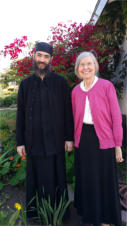
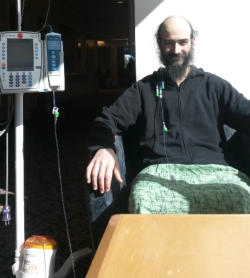
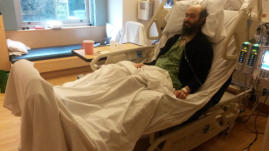
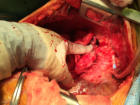
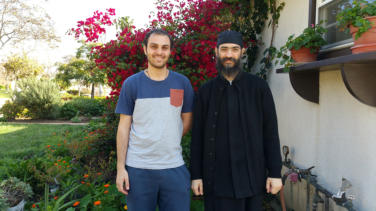
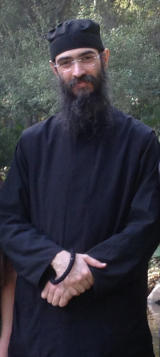
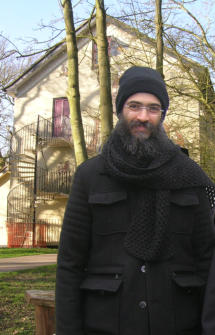


- Aorta
- BAV and Other Heart Valves
- Blood Pressure
- Exercise/Weight Lifting
- Featured Papers
- Guidelines
- Familial TAAD
- History
- Honoring Dr. M.E. Abbott
- Pictures (graphic content)
- Pictures Valvular Strand, Aneurysm (graphic)
- Prosthetic Heart Valves
- Scientific Awards
- Spotlight on Research - Coming Soon
- Video (graphic content)





















